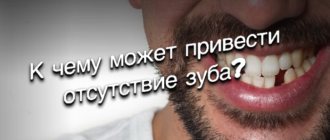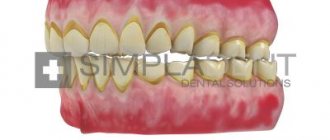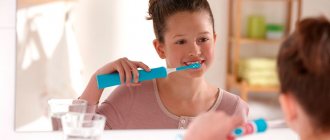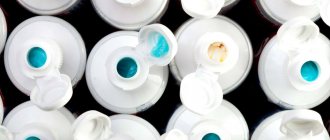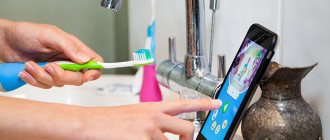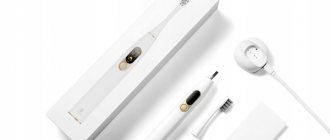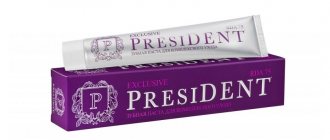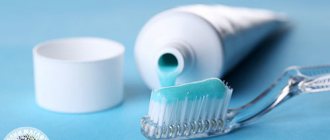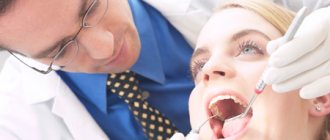If you've run out of toothpaste, don't go shopping, or just want to replace your toothpaste with something else, then you should read this article. It discusses alternative options for brushing your teeth. Making toothpaste at home is easy, and there are also natural remedies.
Alternative to a toothbrush
In a situation where you don’t have a brush at hand, you should use natural material. We are talking about a branch of a coniferous tree, be it pine, spruce or fir. It is enough to tear off a small stalk and place it in hot water. The tip of this product is softened by lightly chewing with your teeth. The end result is something like a brush. The product is carefully passed over the surface of the teeth, removing accumulated plaque.
Separately chew pine needles, which are rich in vitamin C, vegetable oils, and amino acids. In combination, the noted substances have a disinfecting and anti-inflammatory effect on the tissues of the oral cavity. Chewing pine needles for several minutes strengthens tooth enamel and gums.
Using a softened pine twig, it is important to thoroughly clean not only the internal, but also the external surfaces of the enamel. Particular attention should be paid to the bases of the molars. After all, it is here that the salivary ducts are located and the formation of tartar is most often observed.
Application of dental sterilizers
There are different methods for disinfecting toothbrushes; sterilizers are excellent at disinfecting bristles.
They can be used both at home and while traveling. High-quality cleaning of the bristles will help avoid the accumulation of harmful bacteria on it. Of course, you can use regular soap for this purpose, but it is better to give preference to a sterilizer. This is a modern device in which the necessary hygiene item will be qualitatively treated with ultraviolet light, which will almost completely destroy all germs and make the teeth cleaning procedure as effective and safe as possible.
Advantages of ultraviolet sterilizers for toothbrushes:
- destruction of up to 99.9% of all pathogenic bacteria and microorganisms;
- convenience and ease of use;
- in models with large capacity, razors and manicure accessories can be disinfected;
- disinfectors are made of safe ceramic material with good antibacterial properties;
- Low-power ultraviolet lamps in the device are safe for the human body.
It is important to remember that although using a disinfectant helps the bristles remain elastic longer, you need to replace your toothbrush regularly.
Design features
The sterilizer has a fairly simple design, which includes a case for personal hygiene items and a built-in ultraviolet lamp. For the manufacture of cases, bioceramic material is used, which has antibacterial properties.
Most models have special covers made from plastic. It guarantees good protection against the harmful effects of ultraviolet radiation.
The case can be of various shapes. You can choose the classic type, it is compact and made in the form of an interesting geometric figure or toy. There are special holders installed inside the disinfector where brushes are placed.
Some models have several built-in holders, which is convenient for the whole family. In others, they may not exist at all. The lamp in each device is located so that all bristles will be cleaned and disinfected, regardless of what they are made of or how many there are.
Principle of operation
The sterilization process itself is very simple. When you need to disinfect your toothbrush, place it in the case and close the lid of the device well. Then it will do everything itself: it turns on, sets the disinfection time, performs the work and gives a signal that the procedure is over.
Microbes, bacteria and fungi die under ultraviolet rays. Exposure to a special lamp will give an antibacterial effect. Most models are designed so that the device starts working as soon as the lid slams shut.
Disinfectors can be used not only to disinfect brushes, but also to store them there. Because the device will maintain the sterility of the object located in it even after the antibacterial cleaning process is completed.
The sterilizer requires batteries or an electrical outlet to operate. It is absolutely safe for humans, because the device will not turn on if the lid is open. There are models with ultraviolet and ozone treatment, devices with a timer and manual control of operating time.
Variable solutions
Today, different types and models of disinfectants are offered on the market. The most popular options are those that can be used both at home and while traveling. These are very compact portable sterilizers in the form of a case for one hygiene item.
For home use, it is better to purchase a glass-shaped device. It's perfect for the whole family because it can hold up to six items. And thanks to its simple operation, even children can use it. Universal models are very popular, where it is possible to simultaneously irradiate brushes, razors and manicure accessories.
You can choose an option to suit every taste. Sterilizers are affordable for everyone. This useful purchase will help keep your teeth healthy for a long time.
Soda
How to brush your teeth if you don't have toothpaste? A good option is using baking soda. The substance has a non-toxic composition. The powder has an abrasive structure, which promotes high-quality plaque removal. The product has disinfecting properties. In addition to removing bacterial waste products, baking soda is a good teeth whitener.
To brush your teeth without toothpaste, dip a toothbrush or a piece of sterile cotton wool in baking soda. The substance is treated with chewing surfaces. To enhance the positive effect, you can add a couple of drops of lemon juice to the powder. At the end of the procedure, the oral cavity is thoroughly rinsed with water.
After brushing your teeth with baking soda, it is important to avoid eating food and hot drinks for an hour. The abrasive can leave microscopic damage on the enamel. Various types of influences can provoke cracking of the tooth surface in the future.
Doctors do not recommend regularly brushing and whitening your teeth with baking soda. The reason is the same scratching of the enamel by powder crystals. Particles of the substance remaining in the oral cavity can provoke inflammation of the gums and mucous membranes.
How to replace toothpaste
From all sources of information, we often hear that toothpaste effectively removes plaque, but do we know by what means? Manufacturers of cheap pastes use calcium carbonate (chalk), which is a coarse abrasive. It scratches the enamel and thins the neck of the tooth. It's even worse if the paste contains aluminum oxide or silicon dioxide. Crystals are the same hardness as tooth enamel, so the benefits are questionable.
American researchers have proven that additives in toothpastes (sodium lauryl sulfate) cause vision changes in children. In addition, they can accumulate in vital organs, in the blood.
For people who do not like to risk their health, a paste with sodium bicarbonate - tooth salt . However, there is also no confidence in its complete safety.
In addition to toothpaste, there are many effective teeth cleaning products. You will need a toothbrush.
In summer, hygienic cleaning can be done using a small currant sprig . It should be peeled from the bark and chewed crosswise. The juice of the branch will help strengthen the gums.
Young fresh wheatgrass will also work . After chewing, you will feel the fibers, each of which will cleanse the oral cavity.
Heavy smokers may benefit from using orris root . Due to the harmful effects of nicotine on teeth (their staining), caries develops. The root of this plant will prevent the negative effects of nicotine.
Dry horsetail flour perfectly cleanses and stops bleeding gums. It contains silicon, which strengthens teeth and prevents the development of caries.
Calamus root is suitable as a powder for teeth . The basis of such a “paste” should be clay, to which ground calamus root is added.
Herbal powders will help get rid of bleeding gums.
An alternative to toothpaste can be white clay , it will help remove tartar and strengthen the enamel. To prepare the healing powder, you need to take:
- 60 g white clay,
- 6 tablespoons fine salt,
- 3 tablespoons of soda,
- 3 drops of essential oils (tea tree, orange, mint).
The powder can be stored for a long time and smells pleasant. To use, you need to dip your toothbrush into it and start brushing.
A good option for cleaning your teeth is table salt . This tool is available anywhere. Salt fights germs in the mouth and strengthens weak gums. Sea salt will be more useful in this case, as it is rich in minerals. Iodine in its composition will have a bactericidal effect.
Using salt, you can prevent rotting processes and eliminate unpleasant odors. Tartar can be defeated with this simple remedy.
The salt should be finely ground. Dip your brush into it and brush your teeth. If you feel any discomfort, add a little vegetable oil to the salt.
If you have sensitive teeth, try a different remedy. Also, do not use salt in the presence of metal fillings - it can cause corrosion.
Baking soda cleans teeth in the same way as salt, but its frequent use can cause irritation of the gums.
Activated carbon can be found in any first aid kit. Due to its abrasive effect, it is often used to whiten teeth.
The method of use is simple: you need to take a couple of tablets, grind them into powder, moisten the brush in the resulting composition and brush your teeth as usual. You should not use charcoal twice a day, as the enamel may gradually become thinner, and this will cause tooth sensitivity.
An ancient way to clean enamel is to clean it with ash . If you're a fireplace fan, there's bound to be some ash. If you don’t have a brush at hand, you can rub the soft mixture in with your finger. Your teeth will become clean and snow-white.
Ash, unlike coal, is not just an abrasive. It also has disinfecting properties. It is best to use linden ash. You can add a mixture of herbs to the powder for a pleasant taste.
Paste can be made from strawberries. It contains vitamin C, which will help whiten teeth, cope with plaque, and also keep gums healthy.
If you have healthy teeth, then brushing with water . Oddly enough, using this method you can avoid caries (caries forms on poorly cleaned teeth, and water can wash away food debris).
They also brush their teeth with alum and ginger . You need to take 10% alum and 90% ginger, mix everything and crush it.
Powdered milk is suitable as a replacement for toothpaste. With regular use, you can get rid of bad breath and bleeding gums.
an apple 15 minutes after eating . With the help of fruit acids, the plaque on the teeth softens, and then it’s up to an ordinary brush.
Wheat bran and sulfur are also used to clean teeth.
It is also common to use laundry soap to clean the mouth. However, this method is suitable for few due to the unpleasant aftertaste and odor in the mouth. For this reason, the use of soap is possible for such purposes, but there are more pleasant means.
Tea tree oil
People who want to know how to brush their teeth if they don’t have toothpaste should use tea tree oil. The product contains a lot of biologically active elements that inhibit the activity of pathogenic bacteria that parasitize tooth enamel. The product has a pleasant aroma, eliminating bad odors.
The hygiene procedure is carried out according to the following scheme:
- prepare a glass of warm boiled water;
- add about 3-4 drops of tea tree oil to the liquid;
- the composition moisturizes the toothbrush and removes plaque from the enamel;
- Finally, rinse the mouth with the product several times.
It is useful to perform the procedure daily, before going to bed. Regular use of tea tree oil for oral care reduces the likelihood of developing inflammatory processes in the structure of gum tissue. The folk remedy is suitable for combating caries and periodontal disease.
Myth 7. A brush with stiff bristles is the most effective.
Tamara Terekhova recommends buying toothbrushes with soft or medium hardness. Hard ones can only be used by patients with increased formation of pigmented plaque, who also have excellent enamel stability, strong gums, and single fillings. For others, it will injure the oral mucosa and contribute to the abrasion of enamel.
If you have problems cleaning interdental spaces and hard-to-reach places, preference should be given to brushes with milled tips. They easily penetrate into all areas of the tooth and do not injure the gums.
Wood ash
What can you use to brush your teeth instead of toothpaste? An ancient folk method is the use of ash. In nature, cooled coals should be taken from the fire. The substance is ground into powder. Add a couple of drops of water until a thick, paste-like consistency is formed. The product is applied to the finger and passed over the surfaces of the teeth. Finally, rinse your mouth with plenty of water. As a result, the enamel gets rid of accumulated plaque and becomes clean and snow-white.
Wood ash is more than just an abrasive. The product contains potassium, calcium, phosphorus, manganese, iron. The complex of these elements creates a special environment in the oral cavity that is not suitable for the active reproduction of pathogenic microorganisms. If you add ground mint leaves to a paste prepared from ash, you can get a product with a pleasant taste and aroma.
Irrigator
This is a special device that helps remove plaque and food debris using water or medicine. According to dentists, using an irrigator instead of floss and brush is much more effective for the entire oral cavity.
The irrigator (aerator) includes a compressor or hydraulic pump, a water container, a set of different nozzles and a comfortable handle. Water or medicinal liquid is supplied into the mouth by a compressor through a nozzle under pressure. This cleaning removes food debris and plaque, improves blood circulation in the gums, and makes them stronger.
The attachments include classic, periodontal, orthodontic, nasal, with a mini-turbine or a spoon for cleaning the tongue. Irrigators can be used for prevention or therapy if a special solution can be used instead of water. There are devices where water is supplied by pulsation or air microbubbles. The device can be used in any environment, it is only important that there is a charged battery or power supply.
Clay
What to do if you don't have toothpaste? How to brush your teeth? A good idea would be to use white or blue clay powder. The product is absolutely harmless to the body. The substance contains an abundance of microelements that disinfect oral tissues. Brushing your teeth with clay helps eliminate bad odor.
To rid the enamel of plaque, freshen breath and achieve a whitening effect, I act according to the following principle:
- take about 50-70 grams of white or blue clay;
- the product is moistened with a few drops of water;
- the product is mixed until a mass of paste-like consistency is formed;
- add a dessert spoon of liquid honey, as well as a couple of drops of propolis infusion, essential oils of sage and chamomile.
The prepared paste is applied to a damp brush. Brush your teeth, carefully treating the enamel surfaces. Finally, rinse your mouth with water. Performing the procedure in the morning and evening has the most positive effect on oral health.
Additional methods of oral hygiene
There are a number of products on the dental market that help maintain oral hygiene. They can also be useful for cleaning teeth on an occasional basis.
Rinse aids
Mouth rinses are not intended to fully clean teeth . They only kill harmful bacteria located in the oral cavity and prevent the formation of plaque.
Without brushing your teeth, they will not completely remove plaque; your teeth will only be partially cleaned; however, in the absence of other options, this situation is not so bad.
Rinse for cleaning for approximately 1 minute.
Dental floss
Dental floss is unlikely to clean all of your tooth enamel. With its help, you can only complement the cleaning process by eliminating plaque in hard-to-reach places , but cannot replace it in any way.
Without toothpaste and a brush, dental floss will not be suitable for cleaning enamel.
Chewing gum
Chewing gum can partially remove plaque from tooth enamel and freshen your breath well .
For your information! It is recommended to use it after meals, as due to its texture, it effectively cleanses the oral cavity of bacteria remaining after a meal.
It can replace your morning wash, but you shouldn’t expect the effect of toothpaste and brush.
Green tea
To clean your teeth, it is enough to drink green tea, but for greater effect it is recommended to rinse your mouth with it. The herbal drink removes plaque well and has an anti-inflammatory effect .
Fruits and vegetables that clean your teeth
Fibrous fruits and vegetables can help fight plaque because they contain acids and vitamins that help whiten tooth enamel. They help fight tooth decay .
Fruits and vegetables that clean your teeth:
- apples;
- carrot;
- celery.
Healing herbs
When looking for effective folk remedies for cleaning teeth, you should pay attention to plants such as mint, sage, calamus root, thyme, and cloves. These herbs are combined in equal proportions and ground to a powdery consistency. The resulting product is applied to a moistened brush. Perform delicate teeth cleaning. Using the method allows you to remove plaque, disinfect the oral cavity and improve the condition of the gums.
Rinsing
Dentists recommend cleaning your mouth after every meal. To do this, you do not need to constantly brush your teeth, just rinse your mouth. Many manufacturers offer the use of special rinses, however, their composition is not so harmless. What to do in this situation?
Everything is very simple, you can simply rinse your mouth with water, but using herbal infusions or water mixtures will be more effective.
Mint
A water infusion of peppermint will help clean and refresh the oral cavity. To prepare it, you need to pour a tablespoon of mint into half a liter of boiling water and leave for 1 hour. Then cool and strain. The infusion is ready for use.
Kitchen salt
The mineral substance is known for its disinfecting properties. Thanks to its crystalline structure, the product perfectly cleanses plaque from tooth enamel. The effect of salt on the gums reduces the likelihood of developing inflammatory and putrefactive processes. The oral cavity gets rid of unpleasant odor.
You can use sea salt to clean your teeth. The product is a source of a wide range of microelements: iodine, manganese, phosphorus, calcium, silicon, iron. The noted elements have an antiseptic effect on the tissues of the oral cavity.
How to brush your teeth without toothpaste? The salt is thoroughly ground in a mortar until it becomes dusty. Add a couple of drops of vegetable oil. A damp brush is dipped in the substance. Next, teeth are brushed according to the usual principle. Finally, the oral cavity is thoroughly rinsed with water.
Why do you need to brush your teeth?
The most common dental disease is caries . It destroys tooth enamel. When a hole forms, the tooth begins to hurt when eating. If a person does not treat a tooth, sooner or later it will have to be removed. The best prevention of caries is brushing your teeth.
Plaque accumulates on the teeth, which causes bad breath and the formation of tartar. Regular and proper brushing of teeth leaves no chance for caries.

